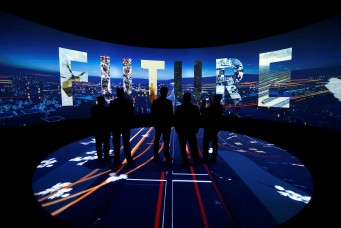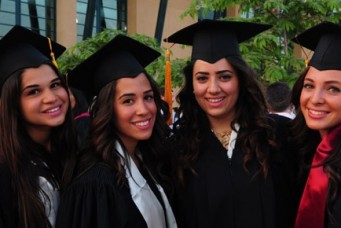Our Urban Dream
The former mayor of Curitiba says decisive battles for the quality of life are being fought in cities, with the future of the planet at stake. He calls for citizen participation on a global scale to overcome poverty, ignorance and environmental degradation. To innovate, he argues, is to begin.

Bus Rapid Transit station, Curitiba, Brazil, April 26, 2011. Simon Norfolk/ INSTITUTE
The twenty-first century marks the consolidation of a demographic shift that was set in motion by the industrial revolution and has not stopped gaining momentum since. Around the world, the supremacy of rural populations over urban ones has been reversed and cities have experienced accelerated growth. They have been through deep transformations that have left a legacy of fantastic possibilities and challenges.
According to the 2007 UN Habitat Global Report on Human Settlements, approximately one billion human beings live in slums—and the figure is growing. Likewise, in environmental terms, it is estimated that 75 percent of greenhouse gas emissions are linked to cities, as many sources including United Nation agencies and the Clinton Global Initiative point out.
Therefore, the search for solutions to enable lifestyles that can bring about a more harmonious relationship between our civilization’s social, economic and cultural demands and nature is ever more pressing. It is in the cities that decisive battles for the quality of life will be fought, and their outcomes will have a defining effect on the planet’s environment and on human relations.
There are those who portray an urban world in apocalyptic colors, who depict cities as hopeless places where one cannot breathe, move or live properly. I do not share these views. My professional experience has taught me that cities are not problems; they are solutions, and so I can face an urban world with optimism instead of fear.
My strongest hope resides in the speed of transformation. For instance, the demographic projections based on the high birth rates of twenty or thirty years ago have not been confirmed, allowing us a more encouraging view on the growth of cities for the next years and decades. This opens up an increasingly positive perspective of evolution in which a doomsday scenario is not the only alternative.
Renewable energy sources, automobiles emitting less pollution, new alternatives of public transportation and communication technologies that reduce the need for travel are preventing the chaos that was predicted for large urban centers. The evolution of technology and its democratization are presenting new perspectives for cities of all shapes and sizes.
In terms of physical configuration, cities of the future will not differ significantly from the ones of yesterday and today. What will differentiate the good city will be its quality of life. Socially just and environmentally sound cities—that is the quest.
By having to directly deal with economic and environmental issues, this quest can foster increasingly positive synergies between cities, regions and countries. As a consequence, it will motivate new planetary pacts focused on human promotion.
You may say I’m a dreamer. But, if I may quote John Lennon, I’m not the only one. The experience of Curitiba, a city where I had the honor of serving as mayor for three terms, among many other cities that have taken these issues to heart in the past decades, shows that this positive scenario is possible.
But for that, a certain sense of urgency is vital. The idea that action should only be taken after having all the answers and all the resources is a sure recipe for paralysis. The planning of a city is a process that allows for corrections, always, especially if you are open to feedback from the people involved.
The lack of resources cannot be an excuse not to act. Some resource-rich cities have seriously compromised their future with costly and equivocated interventions, such as the channeling of rivers and the building of extensive infrastructures for private transport.
To innovate is to start. Hence, it is necessary to begin. Imagine the ideal, but do what is possible today. Long-term planning is necessary, but we need urban policies that can generate change beginning now. The present belongs to us and it is our responsibility to open paths. In the roots of a big transformation there is a small transformation. The essential thing is to make it happen and then take the rest of the time enhancing it. Start creating from simple elements, easy to be implemented, and those will be the embryos of a more complex system in the future.
For instance, the Integrated Mass Transit System of Curitiba (which later became known as Bus Rapid Transit, or BRT), which started in 1974 with one twenty-kilometer axis of dedicated lanes transporting twenty-five thousand passengers per day, has evolved into a system that now transports daily over 2.2 million passengers in the capital and its metropolitan region with a single tariff in over eighty kilometers of dedicated lanes.
Those responsible for managing this urban world must have their eyes looking at the future, but their feet firmly on the ground at the present time. Those that only focus on the daily needs of the population will jeopardize the future of their city. On the other hand, those who think only about the future, disregarding the daily demands, will lose the essential support of their constituents and will not accomplish anything.
Urban Acupuncture
Many cities are losing the battle against degradation and violence exactly because they settled for the view that difficulties were too big and could only be dealt with after all planning instruments and financial resources were in place. Thinking this way only exacerbates the problems, which encourages citizens to believe that a solution is no longer possible.
A city is a collective dream. To build this dream is vital. Those responsible for the city must react. It is crucial that they project a more optimistic outcome for its future, by presenting successful scenarios that can be desired by the majority of the population to the point that citizens will commit to them. To build this dream, this scenario, is a process that acknowledges and welcomes the multiple visions that inhabitants, managers, planners, politicians, businesses and civil society have of their city, and demands the setting of co-responsibility equations to make it happen. The more generous this vision, the more grounded the equations, the more good practices will multiply and, in a domino effect, the more rapidly they will constitute a gain in quality of life and solidarity.
Once the priorities are set, we have to make it happen, and to make it happen quickly. Strategic punctual interventions can create a new energy and help the desired scenario to be consolidated. This is what I see as urban acupuncture: it revitalizes a sick or worn-out area and its surroundings through a simple touch at a key point. Just as in the medical approach, this intervention will trigger positive chain reactions, helping to heal and enhance the whole system.
What I see is that many cities today need urban acupuncture because they have neglected their cultural identities; others because they have neglected their relationship with the natural environment; others still have turned their backs on the wounds left by economic activities. These neglected areas, these scar marks, are precisely the target points for stimulation. The contemporary world demands increasingly fast solutions, and it is the local level that can provide the quickest responses. But it is necessary to have a strategic view, to plan to make it happen for the people and not for centralized and centralizing bureaucratic structures.
It is necessary then not to lose track of the essence of things, to discern within the amazing meanders of today’s available information what is fundamental and what is important, to distinguish the strategic from the daily demands. A clear perspective of future objectives is the best guide for present action. That is to say, to bind the present with a future idea. There are three imperative issues to be addressed when establishing the priorities of a city and considering its scenarios: mobility, sustainability and identity.
In terms of mobility, every city has to make the best out of each available mode of transportation. The secret to success resides in not having competing systems on the same space and using everything that the city has in the most effective way: buses, metro, cars, taxis, bikes, pedestrian areas. For instance, non-proprietary individual modes of transportation can be part of a transit network, such as Paris showed us with the Vélib’ bicycle system. The same concept could be used for compact, energy efficient cars.
It’s my belief that the future of mass transport is on the surface due to its greater flexibility, lower costs and shorter implementation time. Using a mix of features (such as dedicated lanes, on-level and prepaid boarding and high frequency), it is possible to achieve a performance similar to more expensive underground systems. A healthier city happens where the car is not the only comfortable option of transportation; where the energy of unnecessary displacements is saved; where walking along its streets, parks and avenues is encouraged.
Regarding sustainability, the main idea is to focus on what we know about the problem instead of what we don’t. We must remember to transfer this knowledge to our children, who will then teach their children. Simple things from the day-by-day routine of cities can be part of the solution: how each one can help by reducing the use of cars, separating garbage, living closer to work or bringing work closer to home, giving multiple functions during the twenty-four hours of the day to urban equipment, saving the maximum and wasting the minimum. In my last term in office as mayor we implemented a recycling program that was embraced by most of the households and increased exponentially the percentage of recycled garbage in Curitiba. Called “lixo que não é lixo” (garbage that is not garbage), it had school children as its main ambassadors. We developed an educational campaign with specially designed characters (a Familia Folhas, the Leafs Family) that would visit the schools and talk to children about recycling. In turn, the children would take that knowledge home and make sure their parents knew about it. It was an outstanding success.
Sustainability is an equation between what is saved and what is wasted. Therefore, if sustainability equals saving/wasting, when wasting is zero, sustainability tends to infinity. Waste is the most abundant source of energy.
Although the use of basic construction materials such as cement, metal, glass, wood and plastic in the most sustainable way possible can help improve the situation, as certifications such as the U.S. Green Building Council’s Leadership in Energy and Environmental Design program recommend, these advancements will be of little consequence if all that happens is that people move from one sustainable building to the next in an unsustainable urban environment.
Therefore, it is in the conception of cities that the largest and most significant contribution to a more sustainable urban environment can be made—again, provide the city with a structure of growth that does not segregate life and work. A sustainable city, for instance, cannot afford the luxury of leaving districts and streets with good infrastructure and services vacant. Its downtown area cannot remain idle during great portions of the day. It is necessary to fill it up with the functions that are missing.
Last but not least, there is the issue of identity. Identity is a major factor in the quality of life; it represents the synthesis of the relationship between the individual and his/her city. Identity, self-esteem, a feeling of belonging: all of these are closely connected to the points of reference people have about their own city.
Rivers, for instance, are important references. Therefore, instead of hiding them from view or burying them in concrete, cities should establish riverbanks as valuable territories. By respecting the natural drainage characteristics, cities can make sure the preserved areas provide necessary episodic flooding relief channels and still be used most of the time for recreation in an economically and environmentally friendly way. Parks can work within a similar logic, providing areas that people can relate to and interact with.
Historical districts are also major reference points, closely related to the city history since its inception. However, these areas often suffer a process of devaluation and degradation. Finding ways to keep these districts alive by connecting identity elements, recycling outdated uses and hosting a mix of functions is vital.
Cities are the refuge of solidarity. They can be the safeguards of the inhumane consequences of the globalization process; they can defend us from extraterritoriality and the killing of identity. The main component of a more humane city is diversity—of functions, of incomes, of ages, of uses, of typologies and so on. The greater the sociodiversity, the higher the quality of life.
The democratic city is the city without ghettos—be they healthy or poor; housing complexes segregated in remote peripheries or luxurious gated communities within cities. Democracy requires diversity, the coexistence of multiplicity that brings benefits to all. The democratic process requires that all strata of the population participate actively in the making of the city.
Soul of a City
The resources to implement change can be attained through co-responsibility equations: mechanisms to articulate efforts, potentials, and capabilities of the government, private and social sectors.
Nowadays, in the environmental area, mechanisms of compensation for carbon reduction have been created and are being implemented little by little. Let me recall one possible co-responsibility equation aimed at substantial gains for the environment, social development and quality of life. At the United Nations Conference on Global Solidarity: The Way to Peace and International Cooperation, in 2000, I proposed a UN Solidarity Bonus as a compensation mechanism. The country that accomplishes actions of environmental preservation/recuperation would earn an environmental bonus, which could be exchanged for a social bonus such as the relief of foreign debt or direct social investment—and preferably both.
The UN can be the coordinator of such compensation, setting up with the member states an equation that encompasses local governments and accredited NGOs that would share their social mobilization skills, in a virtuous effort of income generation and educational advancement throughout the world.
Especially in the developing world, there are large numbers of people—often unemployed—living in unhealthy, unsuitable areas and, with that, contributing to further deteriorating the environment. The favelas that emerge in large numbers often in fragile environmental areas, such as riverbeds and mountain slopes, are an increasingly more visible reality. The illegal occupation of seemingly vacant land grows, for housing or income-generation activities. These people could be mobilized to preserve their environmental heritage, being paid for it and receiving more access to information and education through the solidarity bonus. This mechanism creates a win-win situation: the less-developed countries would simultaneously diminish their financial debts and also their social debts.
The environmental agenda is a life contract that the present signs with the future. This apparently simple, even naïve mechanism, can have a huge impact in the reduction of poverty in cities all around the world. It is an equation that can rapidly alleviate the needs of the most needy. For the wealthier ones, this equation would ensure, in addition to the environmental benefits, an economic gain in the sense that it would lead in time to the growth of consumer markets in these countries, with the inclusion of large and new contingents. It also represents insurance for democracy and world peace. It is an example to illustrate how help to the environment and to a parcel of the population can be for the benefit of all.
Poverty, ignorance and environmental degradation, among others, are unacceptable debts and can no longer be postponed. And these debts cannot be paid without a global effort and strategy. If we want peace, we must create possibilities to disseminate more rapidly the wealth, knowledge and effective participation of all peoples in the designs of humankind. It cannot be just a ‘mitigating solidarity,’ incapable of generating lasting results. It is critical that we move toward the practice of ‘preventive solidarity,’ capable of generating better perspectives to all peoples. Our fiercest wars are happening in cities, in their marginalized peripheries, in the clash between wealthy and deprived ghettos; the heaviest environmental burdens are being generated there due to our lack of empathy for present and future generations. And this is exactly why it is in our cities where we can make the most progress toward a more peaceful and balanced planet.
A city is a structure of change, even more than a model of planning, than an instrument of economic policies, than a nucleus of social polarization. The soul of a city—the strength that makes it breathe, exist and progress—resides in each one of its citizens.
Jaime Lerner is an architect and urban planner. From 1994 to 2002, he was governor of the state of Paraná, in southern Brazil. He previously served three terms as mayor of Curitiba, Paraná’s capital. Among his many awards are the United Nations Environmental Award (1990), the Child and Peace Award from UNICEF (1996), and the World Technology Award for Transportation (2001).





